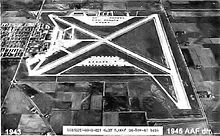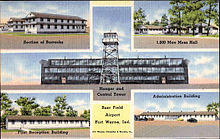Fort Wayne Air National Guard Base
| Fort Wayne Air National Guard Base | |||||||||||
|---|---|---|---|---|---|---|---|---|---|---|---|
| Near AMSL | |||||||||||
| |||||||||||
| Airfield shared with Fort Wayne International Airport Source: Federal Aviation Administration[1] | |||||||||||
Fort Wayne Air National Guard Base is a United States Air Force base, located at Fort Wayne International Airport, Indiana. It is located 7.6 miles (12.2 km) south-southwest of Fort Wayne, Indiana.
Initially established in 1941 as a training airfield for the
History
Paul Baer
Originally named Baer Army Air Base (or more colloquially, Baer Field), the base was named after
Origins

Baer Field was unique in that its establishment at
The land was cleared and the site prepared for construction. There were eight homes, seven barns, and some other buildings to be razed. The airfield consisted of three concrete runways with bituminous shoulders, 6230x148 (NE/SW), 6300x148 (NW/SE), 6000x175 (N/S) including three large parking ramps, several hangars, a control tower and other auxiliary support aircraft buildings. The ground station, located to the north of the airfield, consisted of more than one hundred buildings, all intended to be temporary. Station buildings and streets were also constructed, the buildings consisting primarily of wood, tar paper, and non-masonry siding. The use of concrete and steel was limited because of the critical need elsewhere. Most buildings were hot and dusty in the summer and very cold in the winter. Water, sewer and electrical services were also constructed. Initially there was no paving to the streets, compressed earth served immediate needs.[2][5]
The major part of the original building project was finished by July 1941, about 150 days after the lease for the land was signed by the War Department. and the United States Army Air Forces took possession of the field on 31 October.[2][4]
World War II
Operational training base

The Army Air Forces assigned jurisdiction of Baer Field initially to I Fighter Command, First Air Force. The major responsibility of the First Air Force was the organization and training of bomber, fighter and other units and crews for assignment overseas.[4]
The
The

The airfield was closed for additional construction in June 1942. The runways were strengthened to accommodate the increasing weight of the
Aircraft/crew processing center
By September 1942 the runways were again open, and
In March 1943, jurisdiction of the base was again reassigned from
At the modification center, the plane was updated according to the latest modification orders and received the necessary equipment and changes to suit it for its final destination. From the various modification centers the aircraft were flown to Baer Field. Aircraft were parked everywhere including two of the three runways. The hardstands were also packed with new aircraft awaiting processing.[2]
Baer's responsibility was to inspect the aircraft and make any appropriate final changes; i.e., install long-range fuel tanks, remove unnecessary equipment, and give it a final flight safety test. Baer's inspection of the aircraft was very detailed and involved considerable maintenance, repair and modification. There were two stages. The first was an assembly-line type of operation in the largest hangar where everything was checked. Examples of some of the problems found were leakage of hydraulic fittings, generators not working, loose electrical fittings, instruments inoperative, low fluid levels and missing parts, especially clocks. One C-46 arrived with a block of wood in a carburetor air filter.[2][4]
The second stage was the last inspection. Here the plane was flight tested and then turned over to its crew. The engines were run up, the plane taxied and then flown by military crews to check instruments, radios and single engine operation. The planes were flown north from Baer to
Once completed, the aircraft was delivered to its squadron aircrew. Long range fuel tanks were installed in the fuselage for its overseas movement. If the plane was going to

While the planes were being serviced and made ready for overseas movement, personnel for these planes were also being processed. Pilots, co-pilots and crew chiefs being assigned as a crew for each aircraft. In some cases a Navigator was assigned, depending upon the ships destination. The process typically took 2–3 weeks. Paperwork was handled, equipment was issued and some training accomplished. Baer would process between 10–40 crews per day.[2]
Early in the war, a lot of training was very brief or non-existent. This was particularly true where men and machines were rushed into combat to meet an enemy that had been preparing and fighting for years. This low level of training was also true for crew chiefs. This would change. Training films were first used at Baer in June 1942 and by August 1943 there were 165 training films; later on this would grow to 485 films and numerous other training aids.[2]
New groups which were processed through Baer Field prior to their deployments overseas were:[6]
|
|
Beginning in 1944, Baer repaired and refurbished "war weary" aircraft which were returned from their combat assignments and were overhauled and inspected. After April 1944, new aircrew training was suspended and replacement aircraft for overseas units were processed through Baer, with WASP and ATC Ferrying Command pilots moving checked out aircraft to their worldwide destinations. In addition
Postwar use

Baer continued as a staging base for the I Troop Carrier Command until early May 1945, when its mission changed. With the end of the European War, the base now became an assembly station for redeployment of personnel from Europe to the Pacific Theater. Aircraft staging activities were no longer conducted at the base, however it remained under the jurisdiction of I Troop Carrier Command.[2][4]
Throughout the summer of 1945 many Troop Carrier Groups, which had been equipped and trained at Baer returned to the base from their overseas assignments where they were demobilized and the aircraft were ferried to storage depots in the southwest.[6] This new assignment was short lived, and on 31 December 1945 Baer Field was placed on inactive status. Baer's last assignment was an Army Air Forces separation base. The 333d Army Air Force Base Unit was assigned to the base with the mission to formulate procedures for the transfer of military equipment to other Air Force bases.[4]
On 10 March 1946 the facility was turned over to the City of Fort Wayne for use as a civil airport for one dollar, renamed as "Fort Wayne Municipal Airport". The military airfield was made up of more than 100 buildings, and over the years many of the military buildings were razed and the airfield re-engineered with longer runways to accommodate jet aircraft and as a civil airport.[2][4]
On 1 February 1947 Baer Army Air Base was declared surplus and title to most facilities were transferred to the City of Fort Wayne except for specific areas to be retained for Air Force Reserve and Indiana Air National Guard activities. The AAF maintained a small cadre of personnel at the facility. On 15 December 1946 the 439th Army Air Forces Base Unit (Reserve Training) was activated, replacing the 333d AAFBU, by which consisted of three officers and no enlisted men. The 439th AAFBU's activities consisted of screening, packing and shipping records to appropriate archive depots and furnishing information and assistance to auditors.[4]
On 1 July 1948, the 2467th Air Force Reserve Training Center opened at the base, placed under the jurisdiction of Continental Air Command, Tenth Air Force. It was inactivated due to budget constraints on 27 June 1949.[4]
Air National Guard use

The World War II
The 122d Fighter Group was inactive until 1 February 1951 the unit was activated and federalized due to the
On 1 November 1952 the unit was reorganized and transferred to
Until 2010, the 122 FW flew the
In 2023, it was announced through the
Role and operations

Nicknamed the "Blacksnakes," the 122d Fighter Wing today is operationally gained by the Air Combat Command (ACC). The 122 FW operates from Fort Wayne Air National Guard Base, which is located on the east side of the airport in a secure area away from the publicly accessible facilities.[8]
A unit of the United States Air Force, in a national emergency, the 122d FW may be ordered to active duty by the President of the United States. The primary federal mission of the 122d FW is to achieve and maintain the level of operational readiness that will provide trained and equipped combat-ready tactical units, capable of global deployment, ready for immediate integration into the active Air Force to assure air offense, air defense, or joint action with ground forces.[8]
The 122d FW is available on orders from the Governor of Indiana to assist local authorities in the event of a disaster, disturbance or other emergency. The units of the 122d FW are capable of supporting rescue and relief operations, aiding in recovery from natural disaster, along with protecting the citizens of Indiana and their property.[8]
Based units
Flying and notable non-flying units based at Fort Wayne Air National Guard Base.[12]
United States Air Force
- Indiana Air National Guard
- 122nd Fighter Wing
- 122nd Operations Group
- 163nd Fighter Squadron – A-10C Thunderbolt II
- 122d Operations Support Squadron
- 122nd Maintenance Group
- 122nd Aircraft Maintenance Squadron
- 122nd Maintenance Operations Flight
- 122nd Maintenance Squadron
- 122nd Mission Support Group
- 122nd Civil Engineering Squadron
- 122nd Communications Flight
- 122nd Mission Support Flight
- 122nd Logistics Readiness Squadron
- 122nd Security Forces Squadron
- 122nd Services Flight
- 122nd Medical Group
- 122nd Operations Group
- 122nd Fighter Wing
See also
References
![]() This article incorporates public domain material from the Air Force Historical Research Agency
This article incorporates public domain material from the Air Force Historical Research Agency
- ^ "Airport Diagram – Fort Wayne Intl (FWA)" (PDF). Federal Aviation Administration. 27 February 2020. Retrieved 21 March 2020.
- ^ a b c d e f g h i j k l m n o p q Preparing C-47s for War (Baer Field) Archived 2011-10-05 at the Wayback Machine
- ^ First World War.Com Paul Baer
- ^ a b c d e f g h i j k l m n AFHRA Search Baer Field
- ^ "WW2 Military Airfields including Auxiliaries and Support fields Idaho - New Hampshire". Archived from the original on 2011-07-25. Retrieved 2011-05-02.
- ^ ISBN 0-89201-092-4.
- ^ ISBN 0-8317-1501-4
- ^ a b c d e 122d Fighter Wing Website
- ^ "Archived copy" (PDF). Archived from the original (PDF) on 2011-07-22. Retrieved 2011-05-02.
{{cite web}}: CS1 maint: archived copy as title (link) - ^ "Home". 122fw.ang.af.mil.
- ^ "122nd Fighter Wing receives first batch of F-16 Fighting Falcons". WANE 15. 2023-10-22. Retrieved 2023-11-06.
- ^ "Groups". 122nd Fighter Wing. US Air Force. Retrieved 21 March 2020.
